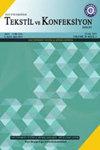INVESTIGATION OF ANTI-PILLING PROPERTIES OF DIFFERENT FABRICS APPLIED WITH POLYVINYLCAPROLACTAM
IF 0.7
4区 工程技术
Q4 MATERIALS SCIENCE, TEXTILES
引用次数: 0
Abstract
Pilling is one of the most important problems in the textile industry still not confidently solved. The problem is a kind of mechanically caused fabric defect consisting by a series of roughly spherical masses of entangled fibers called pills. Many studies have been carried out to define this problem in detail, determine the pilling intensity by different methods and improve the pilling grades of fabrics. One of the most beneficial methods to improve values is chemical finishing by applying specific polymers. In this study, a specific synthesized anti-pilling polymer was used for chemical finishing by padding method. A specific polymer based on polyvinylcaprolactam (PVCL) was synthesized and applied on the fabrics. The polymer has been characterized with FT-IR, NMR, DSC, elemental analysis devices also to optimize application-parameters. Especially pilling grades of blended fabrics of natural and synthetic staple fibres are often worser then other non blended fabrics, PVCL polymer was applied on a selection of different polyester cotton blends or polyester viscose blend, which have pilling values between 2-3. PVCL-Polymer applications were carried out by using these 7 different fabrics. As a result, approximately 1.5-2 pilling degree improvement was achieved. Anti-pilling polymers applied on the fabrics used to improve pilling values often decrease hydrophilicity values of the fabrics and worsen touch. However, the specific PVCL-polymer does not lead to a loss of smooth hand neighter to a loss of smooth fabric touch. On the contrary, it improves both hydrophilicity and smooth touch not causing fabric yellowing. PCVL is distinguished from other products used for pilling improvement in the textile industry.聚乙烯己内酰胺不同织物抗起球性能的研究
起球是纺织行业至今仍未解决的重要问题之一。问题是一种机械引起的织物缺陷,由一系列大致球形的缠结纤维团组成,称为球团。对这一问题进行了详细的界定,用不同的方法确定起球强度,提高织物起球等级。其中一个最有益的方法,以提高价值是化学整理应用特定的聚合物。在本研究中,合成了一种特殊的抗起球聚合物,采用填充法进行化学整理。合成了一种以聚乙烯己内酰胺(PVCL)为基材的特种聚合物,并将其应用于织物上。通过FT-IR、NMR、DSC、元素分析等手段对聚合物进行了表征,并优化了应用参数。特别是天然短纤维和合成短纤维混纺织物的起球等级往往比其他非混纺织物差,将PVCL聚合物应用于不同的涤棉混纺或涤粘混纺,其起球值在2-3之间。通过使用这7种不同的织物进行PVCL-Polymer应用。结果,达到了约1.5-2的起球度改善。在织物上使用抗起球聚合物来提高起球值,往往会降低织物的亲水性,使织物的触感变差。然而,特定的聚氯乙烯聚合物不会导致失去光滑的手,而不是失去光滑的织物触感。相反,它提高亲水性和光滑的触感,而不会引起织物发黄。PCVL与纺织工业中用于起球改善的其他产品不同。
本文章由计算机程序翻译,如有差异,请以英文原文为准。
求助全文
约1分钟内获得全文
求助全文
来源期刊

Tekstil Ve Konfeksiyon
工程技术-材料科学:纺织
CiteScore
1.40
自引率
33.30%
发文量
41
审稿时长
>12 weeks
期刊介绍:
Tekstil ve Konfeksiyon, publishes papers on both fundamental and applied research in various branches of apparel and textile technology and allied areas such as production and properties of natural and synthetic fibers, yarns and fabrics, technical textiles, finishing applications, garment technology, analysis, testing, and quality control.
 求助内容:
求助内容: 应助结果提醒方式:
应助结果提醒方式:


